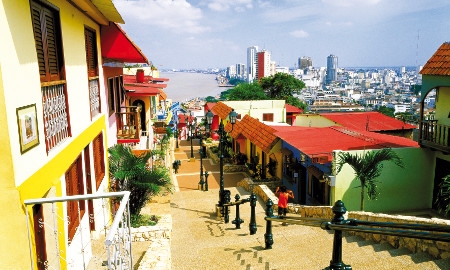Guayaquil is the economic capital of Ecuador due to its entrepreneurial spirit and commercial attitude. It has been overhauled by a huge regeneration program over the past 20 years that has affected the urban fabric of the city and its infrastructure, thereby opening the doors to new business and tourism opportunities. Hospitable and cosmopolitan, Guayaquil is a commercial and financial centre that is confidently looking to the future with the same determination with which its people used to rebuild it from ashes to become the “Pearl of the Pacific”, after the fire that destroyed the city at the end of the 19th century.
Located on the Pacific coast on the banks of the River Guayas, only a few kilometers from where it meets the Pacific Ocean, Guayaquil – or officially Santiago de Guayaquil – is the biggest and most populated city in the Republic of Ecuador. It is one of the biggest urban centers in Latin America with around 2.5 million inhabitants (3 million if you count the metropolitan area). It is the capital of the Guayas province and because of its privileged geographical location the city enjoys warm temperatures, an average of between 25ºC and 28ºC, all year round.
"The key to progress for Guayaquil is the ethical and efficient management of the city in a way that unites"
JAIME NEBOT SAADI,
Mayor of Guayaquil |
Throughout history Guayaquil and its people, known as ‘Guayaquileños’, have demonstrated an entrepreneurial capacity for commerce and industry. They were also the leaders in the fight for independence from the Spanish crown. The beginning of the city’s foundation dates back to 1534, although it eventually came into being officially in 1547 in the Cerro de Santa Ana area, today one of the main tourist areas, with its shipyard and commercial port serving the city and making it, without question, the most important economic powerhouse in all of Ecuador.
Those who visit Guayaquil, whether on business or for pleasure, will discover a city that has been transformed in recent years through a modern development program with the aim of regenerating the urban fabric of the city through wider avenues, better access by land, sea and air, and a modernization of the historic centre that has helped the city become an oasis for its investors, tourists and residents.
The urban regeneration of Guayaquil has become the most important initiative undertaken by the city in recent memory, to guarantee the future of the city as a global, open and vibrant place where people and commerce can sit side by side. A clear example of this progress is the city’s port that has become one of the most important on the Pacific accounting for 70% of Ecuador’s private exports and 83% of all imports into the country.
Ambitious projects to regenerate areas of wasteland have produced new public spaces dedicated to entertainment and leisure. Emblematic areas like ‘el Cerro Santa Ana’, where the roots of the city’s history are found, the neighboring ‘el Cerro del Carmen’ or the central shopping and banking areas are some of the zones to have benefitted from this urban renewal. Another is the Malecón 2000 project, where a huge boulevard that crosses Guayaquil’s shopping and historical center has attracted international awards as a model of urban regeneration.
“Before, people came to Guayaquil to visit a friend, study or to do business, but nobody came as a tourist. However today, Guayaquil is the Ecuadorian city that welcomes the most national and international visitors, we must be doing something right,” proudly claims Jaime Nebot Saadi, the city’s Mayor.
To visit Guayaquil is to live a unique Creole, Ecuadorian experience: it is the opportunity to appreciate at first hand the dynamic and vibrant streets and boulevards, the hospitality of its people and an opportunity to do business.

3 COMMENTS
Que maravilla de ciudad!!!
Quiero ir!!
We need leaders like Jaime Nebot in China.
This city and specially its entrepreneurial people are the drivers of change for Ecuador, if only Quito would follow their example things would be much better.